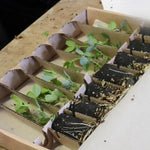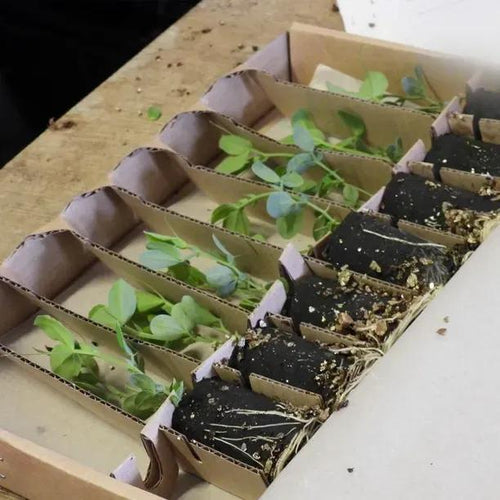Blue Velvet Sweet Pea Plants
Blue Velvet sweet peas (Lathyrus odoratus Blue Velvet) are the go-to variety if you're looking for a reliable deep blue Spencer-type on which to base your annual summer climbing display.
Check out our full range of sweet peas.
Our Sweet Peas are delivered in purpose-designed, recycled cardboard packaging, and are ready to be planted out when you get them.
We generally send them out between March and May, but we will email you with the likely delivery timescale once you have placed your order.
The flowers of Blue Velvet are very deep blue and when they catch the light, they often reflect different shades of violet and purple. Of course, it's all in the name - the blooms have a distinct velvet sheen, so much, so it's hard not to touch them! They're well ruffled, typical of a Spencer type and the long stems and perfume make Blue Velvet an excellent cut flower.
Goes well with other plants
The rich, dark shades of Blue Velvet need to be seen at close quarters to appreciate the subtleties of each petal's texture, so don't hide them at the back of the border. Grow them up obelisks near the front to act as a focal point, and you'll be able to stop and smell the blooms, too.
They make a beautiful contrast to more other colours in the sweet pea range than virtually any other - think pale or bright pink, creams, whites or reds. It's this ability to look good in the company of other sweet peas which makes it such a summer asset. Of course, Blue Velvet doesn't have to be teamed just with other sweet peas - try combining it with a pale climbing rose such as Iceberg Climbing or a tropical flower, like the deep red Cardinal climber (Ipomoea x sloteri).
Sweet pea Blue Velvet is suitable for growing in large containers, but plants will need extra watering and a high potash plant food (such as tomato fertiliser) to keep flowering throughout the season. Keep deadheading faded flowers to make sure blooms keep forming - if seed pods are allowed to develop, the sweet pea's flowering mechanism will switch off. This is why it's a good idea to keep them within easy reach.
Features
- Colour: A rich, intense deep blue
- Stem: Long, great for cutting
- Height: 2m
- Type: Spencer
- Scent: Good scent
- Flowering: May-October
- Planting Months: March-June
- Suitable for use as a cut flower
- Perfect as a contrast with pale varieties
History & Trivia
The Spencer-type sweet peas were bred by Silas Cole, a gardener working for ancestors of Diana, Princess of Wales' family. In 1900, one of his plants threw up a sport with much larger flowers and a wavy petal edge. This bright pink variety was named Countess Spencer and was exhibited at the National Sweet Pea Society's first show, at the Royal Aquarium in 1901.

 Secure, One-Tap Checkout
Secure, One-Tap Checkout
 Hand Picked, Delivered to Your Door!
Hand Picked, Delivered to Your Door! 1 Year Bareroot Guarantee
1 Year Bareroot Guarantee








